Around 56.000 people live in Greenland, predominantly Inuit. Around 20% of the population is born outside the country.
The Inuit submerged from the Dorset culture around 1500 AD. The Little Ice Age was ongoing, making survival difficult because hunting was difficult. Europeans arrived in 1530, Basque men coming first from Spain and building little forts along the coast of Labrador to fish and hunt whales. Inuit people did not try to stop the Basque men, but they did raid their forts to get tools, especially iron tools, for themselves.
Martin Frobisher and John Davis came from Britain in the 1570's and 1580's to sail around the Arctic looking for what they called the "Northwest passage" - a way through from Greenland to Alaska by boat, so that Europeans could ship goods from Europe to China without having to travel all the way around Africa and India. Inuit people met with these men and told them they did not know any Northwest Passage, indicating that exploration was not common within the Inuit.
By 1600, the Basque sailors had stopped coming to Labrador, probably because the whales disappeared from the area. Instead, the Inuit began to meet occasional French and English explorers and traders. Not all of it led to any good; the Inuit caught serious foreign diseases from the visitors, and many people died of smallpox, measles, tuberculosis, and other maladies.
Gradually, more European people came to visit Inuit villages or stayed to try to prove that the Canadians or the United States government ruled the Arctic.
Late in the 1700's many Inuit were converted to Christianity by Protestant missionaries. The missionaries not only introduced new beliefs, but also brought goods like iron tools, knives, and needles, which came in handy in the Arctic. That led Inuit to trade fur for knives and tools from Europe, as well as for food.
Again, the interfering had good and bad qualities. Medicine and doctoral knowledge did come in handy. This led to an increased population in Greenland. In 1953, Denmark put an end to the colonial status of Greenland and granted home rule in 1979, and in 2009 a major milestone came when Greenland transitioned from Home Rule to Self-Government after a referendum that passed with 75% approval. Although a part of the Kingdom of Denmark, Greenland, known as Kalaallit Nunaat, maintains much autonomy today.
Transport in Greenland is very hard due to how scattered the municipalities are. Ships had to be used for longer transports, but around 1940, in the Second World War, airplanes became increasingly popular in Greenland. Canadians used planes and interfered with Inuit lifestyles by forcing some of them to learn Canadian ways of doing things, and forcing grown-up Inuit to settle down in towns instead of being nomads.
Of a population of 55,745 in 2025, 80% of Greenlanders identify as Inuit. Their economy is almost entirely based on fishing, predominantly shrimps.
Source:The Arctic by Richard Sale, Arctic Human Development Report









